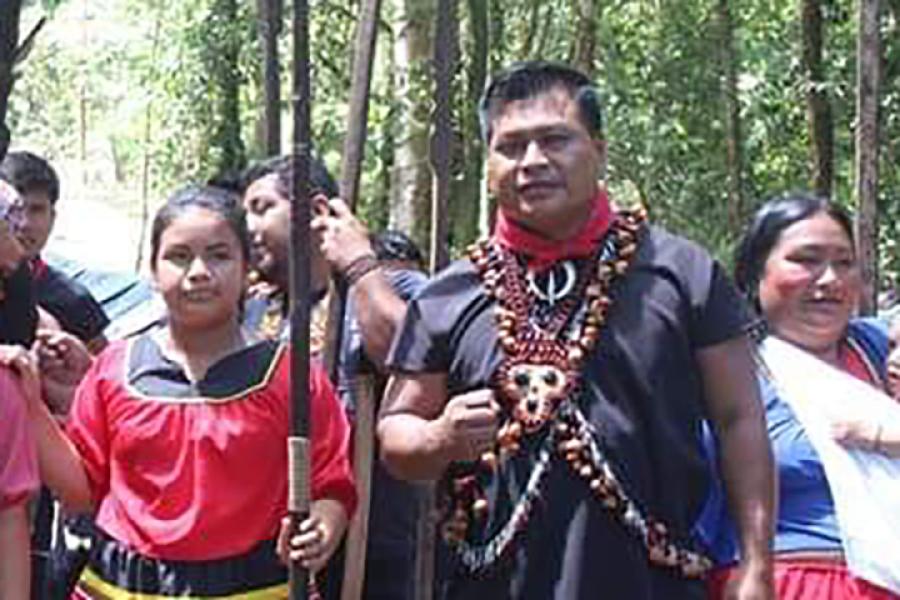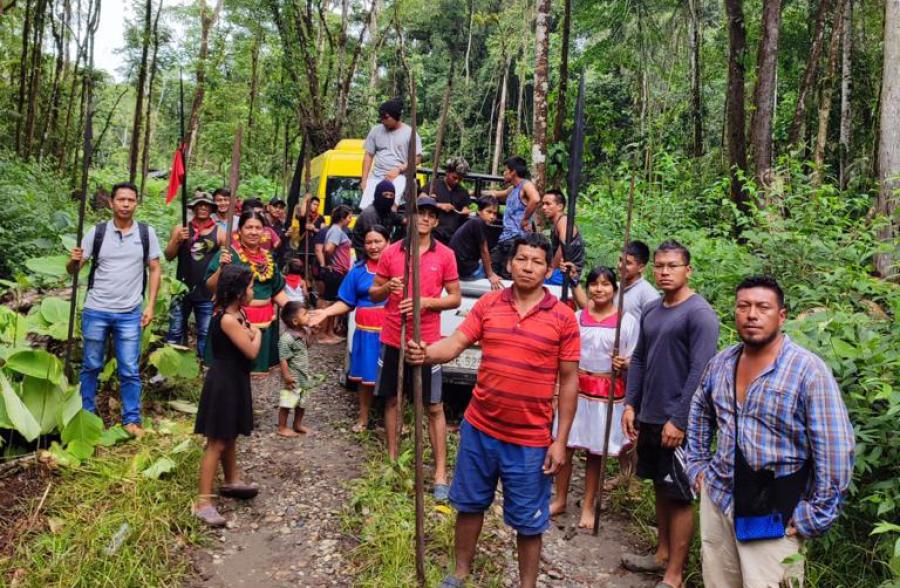On the spine of the Andes, one indigenous community’s success in managing its land in the buffer zones of an Ecuadorian natural preserve demonstrates the power of self-initiative to counter the bottleneck of increasing population and finite resources. As the rationale that biological diversity must be mercantilized in order to fund saving it is gaining steam in some circles, others say that the cry of resource deficiency is being used to promote privatization of public lands. Two distinct resource management models are being considered here. Which wins will have significance for indigenous pueblos, the nation, and beyond.
Harsh but beautiful, the glacier named Cayambe looms above the agricultural communities of El Hato, a striking icy peak with a train of clouds billowing out behind. In the foreground, falls cascade down a ravine into a lush valley. Carlos Farinango, a Cayambe man from El Hato, stands beside me watching the hillsides of grass shimmering in the brisk mountain wind. We stand in the buffer zone between El Hato and the limits of Ecuador’s Ecological Reserve Cayambe-Coca, known as Recay. Farinango describes the condition of this land just 10 years before: “The hillsides were bald, some tufts of grass, nothing more. Sheep were chewing at the roots of bushes to eat.” A decade ago, the land had been utterly denuded by years of overgrazing and burning.
This high-altitude steppe, called páramo, is unique to the Andes and surprisingly rich in plants and animals. It is often described as “the birthplace of water”—ground cover acts as a great sponge, absorbing permanent mists and melting glacier ice, which flows into streams that become great rivers. The páramos of Recay are the source for 13 major waterways in Ecuador’s vast river system, flowing out in literally every direction from the massive glacier.
The confederation of Cayambe tribes strongly resisted the empires of the Inca and then the Spaniards. Finally conquered in the late 16th century after years of siege, they were pushed out of fertile bottomlands to just beneath the frigid upper páramos. For centuries Cayambes worked as sharecroppers for large landowners, or hacendados. From colonial times into the 1990s, they labored several days a week on the haciendas in exchange for the ability to graze animals on the páramo beyond. The lack of coordination of the Cayambes’ grazing and burning over decades caused its condition to decline drastically.
Reacting to the desertification of the upper páramo, people in the communities who depend on the water flows from above occupied the offices of Ecuador’s Environmental Ministry, refusing to accept the agency’s proposed management plan. Asserting their ancestral right to access the páramos, they developed their own management strategy and moved ahead on implementation despite lacking government approval.
As a first step, the community put a stop to indiscriminate burning. They then developed land management practices through a process of trial and error, gathering thoughts and experiences from the community as they went. Because the purpose of burning is to generate new growth for grazing; once indiscriminate burning was halted they encountered the challenge of generating new growth without drying out the land. The community tried various methods of managing the grass for grazing, such as chopping it down by hand and bringing crowds of community members up to the
páramo
to stomp it down. Finally they settled into controlled burns on the slopes, which allowed space for new growth while at the same time keeping the cattle out of the drainages where water flowed.
Today Farinango heads the Corporación El Hato, composed of five communities, which has managed the páramos since 1996. The corporation has no funding—when projects are needed such as construction of water storage tanks and canals in the agricultural zone, or roundups of animals grazing in the páramo, they are executed through mingas, or collective community work sessions. “If we had waited for the state to take care of the páramo … it would never have happened,” Farinango says.
After nearly 10 years of community management, the páramo of El Hato has regenerated, and more water flows down to the communities. As habitat has recovered, wild animals such as the endangered condor and Andean spectacled bear have returned to the area. The communities likewise have begun to thrive again, with increased water providing greater abundance in their fields. Rejecting the bad and keeping the good from their history, the Cayambe are nurturing the recognition that their survival depends on the conservation of the Earth—of which they view themselves a part.
“People from other communities come here to learn from us,” Farinango says. In the future, the corporation would like to “remove all grazing to have more water.”
Ecuador, though small in area, is deemed “mega-diverse” by scientists. Acre for acre it contains a level of species richness unmatched in the rest of the world. With the highest population density in South America, it’s also the third most indigenous, with at least one quarter of the population composed of indigenous peoples. Because protected areas cover almost 19 percent of the nation’s surface area, many indigenous and mestizo communities lie adjacent to or within natural preserves.
Ecuador’s capital city of Quito has witnessed a population explosion—today it is a city of nearly 2 million. As it has grown, so has demand for water. The glacier and páramos of Recay provide life-giving fluid not only for irrigation in Cayambe and other agricultural communities, but also for human consumption in Quito. Though a 1996 management plan for Recay mentions a water-use plan, one has yet to materialize, purportedly due to a lack of resources.
Some would say that the cry of “no money” has been used to justify the involvement of funding sources incompatible with conservation. Alfredo Luna is an Ecuadorian biologist who has worked for the government, and currently with a volunteer-run environmental watchdog group. One focus of Luna’s investigation has been The Nature Conservancy (TNC), which in 1997 with the Ecuadorian Fundación Antisana created the Fund for the Conservation of Water, or FONAG. Maria Helena Jervis, executive director of Fundación Antisana, described FONAG as “a mixed government and private trust.” Quito’s water company, an electric company, a beer company, and TNC direct FONAG and decide the fate of its funds, with the Quito water utility as the heavyweight of the group. Currently it claims close to $2 million in income, accumulated from a raise in the cost of water to Quito consumers who were never notified, and who “most likely never even noticed,” according to Jervis.
As far as where that money is going, it is difficult to find information to support the existence of a FONAG conservation project. “Right now the fund is capitalizing itself,” Jervis said. A 2002 report by TNC states, “Implementation of [FONAG] watershed protection activities has been deferred until 2002, when it is expected that sufficient resources will have been accumulated.” A 2004 report by USAID states that for 2003, “Technical assistance will be provided for the full operation of the Water Fund (FONAG) to begin implementing concrete conservation projects within the watersheds that supply Quito.”
FONAG describes nature in economic terms, stating in its promotional materials that “to maintain the regeneration of the hydrological resource, investment is required.” This language to Luna is scientifically inaccurate. Not only does it equate resources with money, but it suggests that negative human intervention is a given, making such “services” indispensable.
Roberto Troya, director of TNC’s Ecuador program, says that long-term financing is the most difficult challenge facing conservation in Ecuador. While the notion that privately managed funding can fill the financial gap sounds appealing, it may also represent a conflict of interest. For the Quito water facility, conservation of water resources in Recay means guaranteeing supply for future consumption, which is not the same as ecological preservation. The crux of this conflict lies in infrastructure projects, such as dams and their attendant roads and canals, which have a wide range of environmental impacts.
For indigenous and agricultural groups including the communities of El Hato, the perception that water in the reserve is on the privatization chopping block runs so strong that they have opposed an agreement of cooperation between Fundación Antisana and the municipal government of Cayambe. For these groups, plans to charge for “environmental services”—in other words, to assure that nature will provide water—cut them off from their traditional connection with the land in order to impose a profit model.
Using terms similar to the “environmental services” of the water privatization plan, an initiative known as the “Biodiversity Law,” drafted by the National Working Group on Biodiversity, would transform natural diversity into commerce. Allowing the state to regulate the extraction of biological resources, the law applies fees for genetic patents and grants private entities the right to use resources in natural protected areas. In early 2004, the Confederation of Indigenous Nationalities of Ecuador (CONAIE), along with labor and community groups, demanded the immediate suspension of the proposal, calling it unconstitutional and a violation of collective rights.
In a process similar to the establishment of FONAG, the law is founded on the precept that biological diversity must be mercantilized in order to fund saving it. In it, the Cayambe and CONAIE see the state working closely with non-governmental organizations, the latter becoming “technical experts” or intermediaries to the market—thereby guaranteeing those NGOs funding and work contracts.
Community management of the páramos of El Hato is achieved without money—just will and work, shattering the rationale of those who favor privatization. While El Hato acts as a model for other communities, it also illustrates the struggle of Native people using their own cultural methods to survive repression by living with the land and working together. “Autonomy begins with our territories. Our lands are sacred, and that’s where we have our richness,” says Leonidas Iza, former president of CONAIE.
Meanwhile, the competing model, embodied by the language of “environmental services” and policies such as the proposed Biodiversity Law, continues a 500-year trend of ceding the resources of Latin America to the global market.
Recay appears to be the next grounds for water wars, and the model that wins here will affect more than just the residents of El Hato and Quito. As world population explodes and the scenario is repeated, its implications span the globe.
Sonya Angelica Diehn (www.sonya.espora.org) is an independent writer and video-documentarian from Tucson, Arizona. With Pan Left Productions in Tucson she has produced and released several videos on environmental issues and the impacts of neoliberal policies. Covering social movements in the United States and Latin America since 1999, she is currently traveling in South America researching, writing, and recording video footage on topics including indigenous and environmental protection movements.


